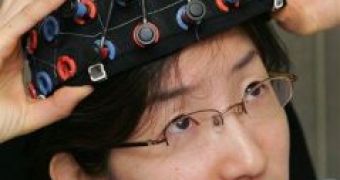The Japanese company Hitachi developed a brain-machine interface, a new technology that allows you to control electronic devices without lifting a finger. It does that by reading brain activity and analyzing slightchanges in the brain's blood flow to detect brain motion, which is then translated into electric signals.
In one-way brain-computer interfaces, computers either accept commands from the brain or send signals to it (for example, to restore vision) but not both. Two-way BCIs would allow brains and external devices to exchange information in both directions but have yet to be successfully implanted in animals or humans.
It's not exactly like the brain implants in fiction, so The Matrix is still far away, but it's a major step towards real-time, two way direct interactions between the human brain and electronics.
For now, the cap-like device connects by optical fibers to a mapping device which is then connected to a toy train set through a control computer and a motor to power up the train. "Take a deep breath and relax," said Kei Utsugi, a researcher, while demonstrating the device on Wednesday.
A reporter wearing the cap started performing simple calculations in her head, and the train started moving, indicating that the brain's frontal cortex, which handles problem solving, was in activity. It's actually activity in this part of the brain, that makes the train run and all you need to do to stop the train is stop thinking about math.
This new technology is called optical topography and can send small amounts of infrared signals through the surface of the brain to map out changes in blood flow, and then converts the obtained information into signals that control the electronic device.
Various practical applications could be envisioned, from replacing remote controls and keyboards, to helping people with disabilities operate electric wheelchairs, beds or artificial limbs.

 14 DAY TRIAL //
14 DAY TRIAL //